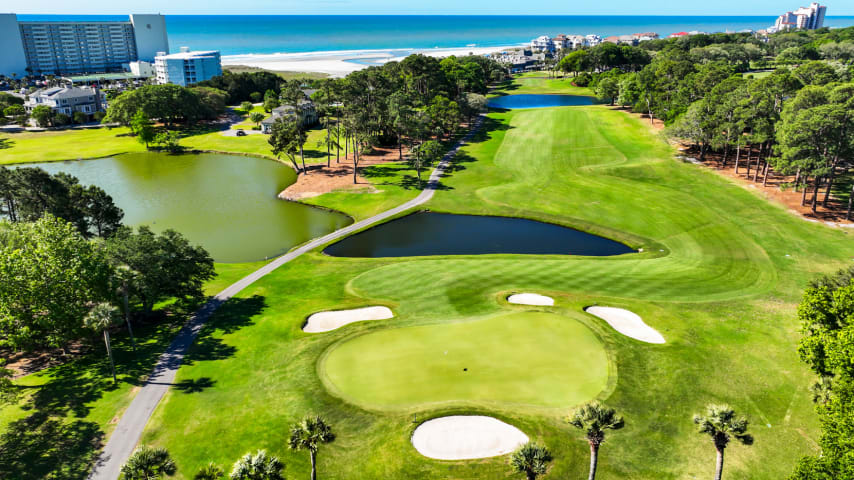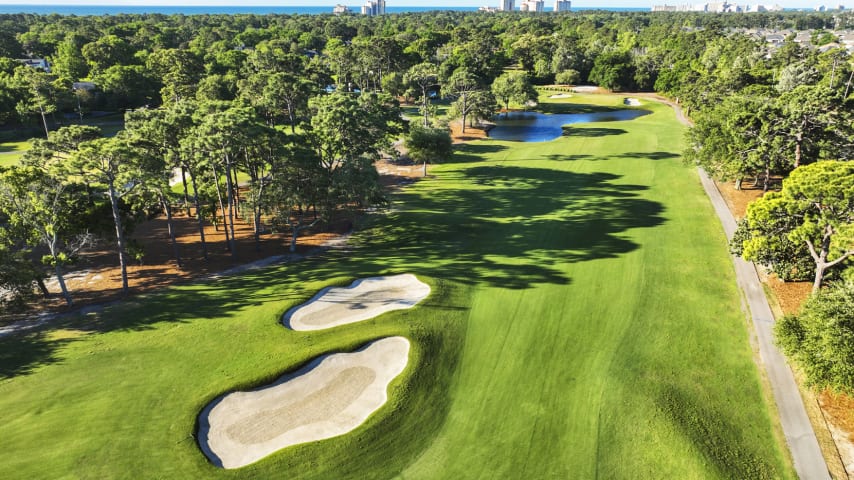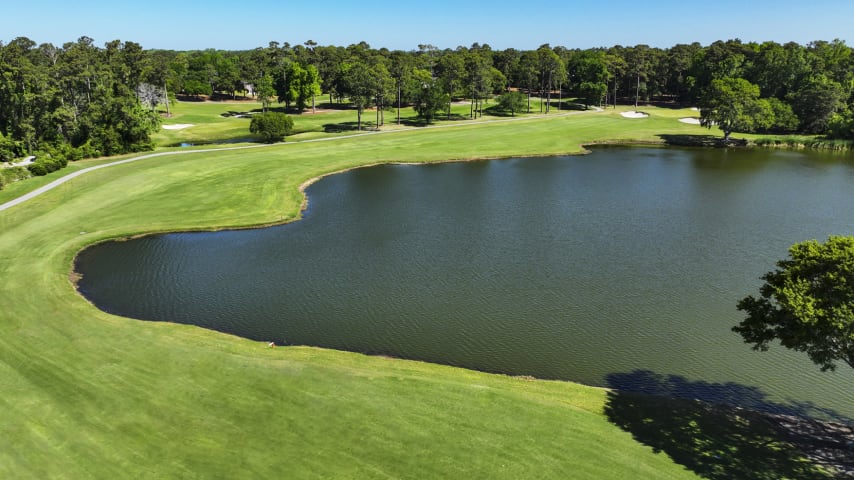Five things to know: Dunes Golf and Beach Club in Myrtle Beach
6 Min Read

The Dunes Golf & Beach Club measures 7,450 yards and features a slope rating of 76.1. (Jim Maggio/Golf Tourism Solutions)
Written by Bradley S. Klein
One of Myrtle Beach’s first courses is hosting inaugural Myrtle Beach Classic this week
A single golf hole deserves the credit for making Myrtle Beach, South Carolina, the first resort destination ever put on the map. The Dunes Golf and Beach Club is certainly the most famous of the courses on South Carolina’s Grand Strand, and its 13th hole remains one of the region’s most iconic. It is aptly named “Waterloo” and wraps around Lake Singleton, creating a 90-degree dogleg right around the water.
This week, the Dunes Club hosts the inaugural Myrtle Beach Classic, adding to a tournament history that also includes the 1962 U.S. Women’s Open, PGA TOUR Champions’ Tour Championship, PGA TOUR Q-School and the 2017 U.S. Women’s Amateur Four-Ball. The course measures 7,450 yards and features a slope rating of 76.1.
Here are five things you need to know about the historic venue hosting the newest PGA TOUR event.
1. A pioneer
When it opened in 1949, the Dunes Club was the second course built in and around Myrtle Beach. It was preceded only by Pine Lakes Country Club (1927). A savvy marketer, Jimmy D’Angelo, was the head pro at the Dunes and managed to put together an annual media event of golf and baseball writers. The gathering was timed to catch the scribes on their way north from covering Spring Training in Florida, as well as from the Masters in Georgia. D’Angelo treated them to golf, an open bar and the wonders of the beachfront resort.
The popularity of the town for sports journalists eventually led to a discrete gathering of writers, editors and publishers in Pine Lakes’ elegant Georgian clubhouse in February 1954 that marked the founding of Sports Illustrated magazine. Myrtle Beach quickly grew into an affordable destination for golfers, ultimately gaining more than 100 courses and a reputation as “The Golf Capital of the World.”
2. A big break
Robert Trent Jones Sr. (RTJ) is a legend of golf course architecture, but back in the late 1940s, Jones was still struggling to establish himself in the industry. Though he was well-trained for the task, Jones’ career – like the entire golf industry – was interrupted by the Depression and World War II and took time to emerge postwar. He had a number of low-budget public courses to his credit and was one of 14 founding members (along with Donald Ross) of the American Society of Golf Course Architects in 1947. He’d also just finished redesigning the par-3 16th hole at Augusta National and had begun working with Bobby Jones on Peachtree Golf Club in Atlanta. Then Robert Trent Jones Sr. landed the assignment for the Dunes Club, which became his first nationally acclaimed solo design. It also established his reputation for designing courses that required a style of aerial power golf that repudiated the classic-era ground game.

This week, the Dunes Club hosts the inaugural Myrtle Beach Classic, adding to a tournament history that also includes the 1962 U.S. Women’s Open, PGA TOUR Champions’ Tour Championship, PGA TOUR Q-School and the 2017 U.S. Women’s Amateur Four-Ball. (Jim Maggio/Golf Tourism Solutions)
It helped in giving shape to the Dunes Club that he worked with the same construction foreman – Bill Garrett – with whom he worked at Augusta National and Peachtree. Soon after the Dunes Club opened, they returned to Augusta National to create today’s par-4 11th that features a pond left of the green and a tricky approach from the right. Soon, RTJ was the subject of a fawning profile by writer Herbert Warren Wind in The New Yorker that highlighted his renovation of Oakland Hills Country Club’s South Course, turning it into an absolute beast that tormented the game’s top players. Ben Hogan shot a final-round 67 to win the U.S. Open there and declared, “I'm glad I brought this course, this monster, to its knees." RTJ’s reputation was set.
3. Keeping it with the Joneses
The Dunes Club embodies Jones’ commitment to demanding power golf featuring well-bunkered, slightly elevated greens that require an aerial approach. It remains a thrilling period piece, a throwback to when golf went from a ground game to an aerial game. Even with a total elevation change of only 26 feet on the property, the course presents itself well from each tee due to the meticulous routing and the use of native contours.
Unlike modern architects who scatter small tees at various distances and angles, Jones cultivated a trademark reliance upon long runway tees, some of them stretching 60-70 yards from back to front. Jones also heavily bunkered his greens, requiring aerial approach shots hit to carefully controlled distances. He then segmented the putting surfaces, making it crucial that players hit their approaches close to the hole, lest they be left with a lengthy putt that must traverse multiple ledges.

The Dunes Golf & Beach Club hosts the inaugural Myrtle Beach Classic. (Jim Maggio/Golf Tourism Solutions)
The Dunes Club design has been kept in the Jones family thanks to extensive renovation by Trent Jones’ younger son, Rees Jones, over the last 20 years. The scope of work has been extensive but involved no re-routing of any holes. Instead, there was refinement of some green sites, addition of fairway bunkers, course lengthening, a new irrigation system, practice tee enhancement and conversion of the putting surfaces to Champion ultradwarf bermudagrass for better performance in warm weather. Greens were also expanded to an average size of 6,000 square feet – large enough to provide room for the ball to roll out under today’s greater putting speeds. “I tried to build it for today’s play while preserving Dad’s design character,” said Rees.
4. Waterloo
For all its subtlety, the Dunes Club struck a note among golfers because of its par-5 13th, a scimitar-shaped par 5 that turns right around Lake Singleton and is the epitome of heroic design. Images of the hole started appearing in magazines, books and on lists of “best holes,” and it remains the kind of memorable hole that you anticipate, think about the entire round, and replay in your mind long after playing it.

The 13th hole at the Dunes Golf & Beach Club is aptly named “Waterloo” and wraps around Lake Singleton, creating a 90-degree dogleg right around the water.
Technically, it’s less a dogleg than a 90-degree right angle – rare among golf holes. The fairway narrows as a player gets farther from the tee, pinching down to about 18 yards across at 330 yards from the tee. Players with enough nerve and control to place their tee shot 280 yards off the tee and just past a line of oaks on the right will have a shorter shot across the water to reach the green in two than a player who hits a longer drive to the left side of the fairway.
5. Fast track
Due to extensive drainage and because it sits on a naturally sandy site, the Dunes Club plays very firm. This makes for an unusually interesting playing field, one that will reward precise shot-making. Fairway landing areas off the tee are on the narrow side – 20 to 25 yards across. The greens are much harder to hold when played from the 2-inch overseeded ryegrass rough, so accuracy off the tee will be rewarded rather than “bomb and gouge” golf. That is because 16 of the greens are bunkered on the left and right – the other two are only bunkered front right. Miss a fairway and controlling a second shot will not be easy.
All of which will make for some interesting golf to watch as PGA TOUR players confront this traditional test for the first time.




